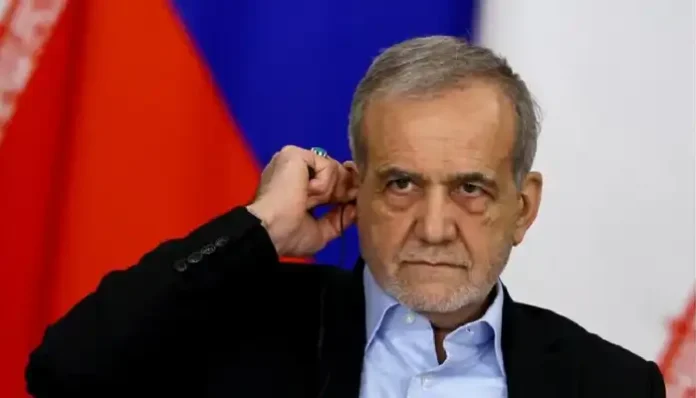LIPUTANKHUSUS.COM – Iranian President Masoud Pezeshkian sustained minor injuries following an Israeli missile strike that targeted the Iranian capital, Tehran, during the 12-day war that broke out last month. The incident, first reported by Iran’s semi-official Fars News Agency, has raised fresh concerns about the scale and precision of Israel’s military operations and the possibility of an internal security breach within the Iranian government.
Targeted Strike in West Tehran
According to the Fars report, the missile strike hit a secure government building in West Tehran, where several high-ranking Iranian officials, including President Pezeshkian, were holding a closed-door meeting. The missiles struck entry and exit points of the underground facility, a tactic Iranian media compared to Israel’s past operations targeting Hezbollah figures, such as Hassan Nasrallah.
President Pezeshkian was reportedly injured during the evacuation, though he managed to exit safely through an emergency route with the assistance of his security team. Iranian authorities confirmed the injury was minor and that the President has resumed his duties.
Suspected Internal Leak
What has particularly alarmed Iranian intelligence and defense officials is the accuracy of the strike, prompting suspicion of an internal leak. Officials are currently investigating how such precise targeting of a highly secured location was possible, especially given that the meeting was unpublicized and held in a restricted area.
The incident has intensified scrutiny over domestic security protocols and potential foreign infiltration, though no official suspects or groups have been named as of yet.
Western Media Criticized
Fars News criticized Western and Israeli-affiliated media for what it described as “deliberate silence” over what it called an act of state terrorism. The outlet accused mainstream Western coverage of downplaying the seriousness of the Israeli missile strike and its potential consequences under international law.
The 12-Day War: A Brief Overview
The 12-day conflict between Israel and Iran erupted on June 13, 2025, after Israel launched coordinated airstrikes on Iranian military, nuclear, and civilian infrastructure. The escalation quickly spiraled into the most direct confrontation between the two nations in years.
Casualties:
- Iran: At least 606 dead and 5,332 injured, according to Iran’s Ministry of Health.
- Israel: Iranian retaliatory attacks, including missiles and drone strikes, reportedly killed 29 people and injured over 3,400.
The war ended following a U.S.-brokered ceasefire agreement that came into effect on June 24. While the ceasefire remains fragile, both sides have ceased active hostilities for now, though diplomatic relations remain frozen.
What This Means for the Region
The injury to President Pezeshkian during a targeted attack highlights the unprecedented reach of Israeli military operations, as well as Iran’s vulnerabilities in high-level security. Analysts warn that such developments could escalate tensions in the long term, especially if Iran pursues retaliatory action in response to what it calls “state-sponsored terrorism.”
With Iran’s leadership directly impacted and domestic calls for accountability mounting, the region may be entering a new phase of heightened alert, even after the ceasefire.



![Polls Reveal Cracks in Trump’s Second-Term Presidency US President Donald Trump arrives on the South Lawn of the White House in Washington, DC on July 29, 2025 [Jim Watson/AFP]](https://liputankhusus.com/wp-content/uploads/2025/08/US-President-Donald-Trump-arrives-on-the-South-Lawn-of-the-White-100x70.webp)







